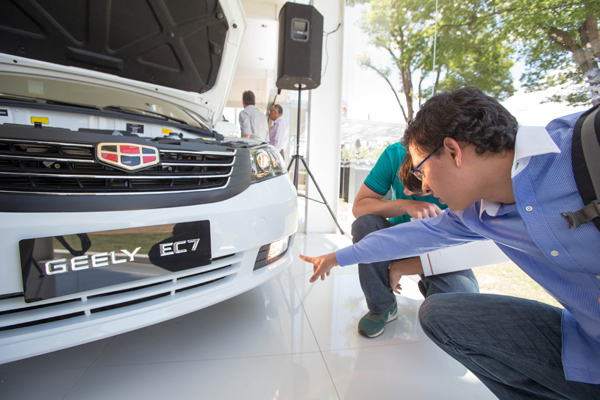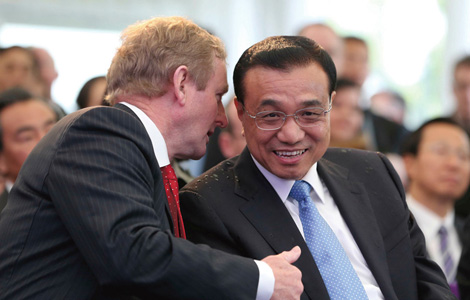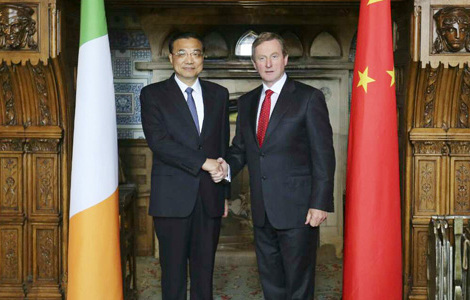No easy ride for Chinese automakers
Updated: 2015-05-18 12:32
By Huang Ying(China Daily USA)
|
|||||||||
 |
|
China's Geely Auto company officially entered the Brazilian market with the launch of its flagship model, the Emgrand EC7, last year. Xu Zijian / Xinhua |
Chinese automakers making footprints in South America should make more efforts to understand the local markets before coming up with expansion plans there, industry analysts said.
In 2013, South America was the largest export destination for Chinese automakers. That year, China exported 286,500 vehicles to the region, up 19 percent compared with the previous year, accounting for 30 percent of the total number of vehicles exported, according to the China Association of Automobile Manufacturers.
Among the top 10 export destinations for Chinese carmakers in 2013, four are South American countries - Chile, Peru, Colombia and Uruguay.
Major Chinese auto brands such as Chery, Geely, Great Wall and JAC all have exported vehicles to South America, and some of them have already invested in setting up plants there to avoid tariffs and save more on logistical costs.
However, from January to November 2014, China's total exports of vehicles have been on a downward trend, with the number of vehicles exported totaling 810,400, dropping 9.3 percent from a year earlier, according to the auto association.
Slowing market demand from overseas and trade barriers contributed to this shift, industry experts said.
Brazil's new policy on tariffs on imported cars is one of the major factors driving the downward trend. It increased the taxes on imported vehicles by 30 percent from December of 2013, causing the cost of importing Chinese cars in Brazil to grow between 25 percent and 28 percent.
Brazil, as the fourth-largest auto market in the world, takes up between 60 percent and 70 percent of South America's auto market.
In 2014, Chery exported 110,000 vehicles, ranking the first among Chinese automakers 12 years in a row. Its accumulated auto exports have exceeded 1 million units.
Chery, as one of the most aggressive Chinese brands in the market, opened its first factory in Venezuela in 2011.
Chery's first auto plant in Brazil started up at the end of last year. The plant will have an annual production capacity of 50,000 units in its initial phase. When its second-phase project is completed, in which a research and development center and auto parts suppliers will be included, the annual manufacturing capacity will reach 150,000 units.
"Before making the decision of establishing plants in South America, Chinese auto brands should make sure that annual sales of vehicles in the market would reach at least over 100,000 units, while 300,000 units is best," said Jia Xinguang, an independent auto industry analyst.
The ownership of vehicles in South America is far lower than that in Europe and the US, and the market potential for Chinese automakers to develop on the continent is huge, according to Shi Jianhua, deputy secretary-general of the China Association of Automobile Manufacturers.
In addition, simply opening a plant in a local market is far from enough.
"An integral part of a long-term and sustainable strategy should include plans for setting up assembly plants, auto parts factories, post-sales services offices and research and development facilities," said Jia.
Also, in a market like Brazil, which has been dominated by foreign brands for years, it's not easy for Chinese brands to get a slice of the market share in competition with other foreign rivals.
"It's becoming very essential to know about the characteristics of its auto market ... and concrete market surveys and investigation are very much required for Chinese brands building plants there," said Jia.
He offered an example by saying that the fuel of vehicles in Brazil is mainly alcohol, which is produced from sugarcane - a quite distinctive property of the country's auto industry.
Chinese automakers are in fierce competition with other global auto giants in the South American market, including General Motors, Ford Motors Company and Toyota Motor Corp. Besides, the economic downturn in South America has caused exchange-rate losses and financing difficulties for Chinese auto manufacturers there, Shi said.
Shi thinks in order to support the rapid growth in auto exports, improvements in Chinese auto companies' human resources, capital and other fields are required.
"The culture difference will also play a critical role for Chinese brands' expansion strategy there," Jia added, because consumers on the continent have been accustomed to the purchase and application of vehicles produced by developed countries.
Another unhealthy part of Chinese automakers' expansion in the South American market is the price war among domestic auto brands.
"The trend will grow in favor of exporting vehicles rich in exclusive innovation and advanced technologies, instead of comparatively low price," said Jia.
huangying@chinadaily.com.cn

 Premier, Irish PM tour dairy farm
Premier, Irish PM tour dairy farm
 China, Ireland sign agricultural deals
China, Ireland sign agricultural deals
 Monks practice martial art at Quanzhou Shaolin Temple
Monks practice martial art at Quanzhou Shaolin Temple
 The world in photos: May 11-17
The world in photos: May 11-17
 Daredevil breaks blindfolded tightrope walking record
Daredevil breaks blindfolded tightrope walking record
 Helicopter-hailing app sees huge response for ride over Beijing
Helicopter-hailing app sees huge response for ride over Beijing
 Ten photos you don't wanna miss - May 18
Ten photos you don't wanna miss - May 18
 Huge mahjong tiles challenge participants
Huge mahjong tiles challenge participants
Most Viewed
Editor's Picks

|

|

|

|

|

|
Today's Top News
Li arrives in Brasilia to sign agreements
Li samples products of an Irish farm
Premier eyes growth points on Brazil trip
9 dead in shootout in Texas
Alibaba denies luxury group's counterfeit claim
J-10 fighter jet 'good choice for Argentina'
China, US should not let distractions derail ties: Xi
China, Ireland sign agricultural deals
US Weekly

|

|







